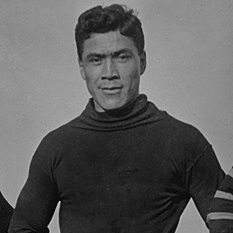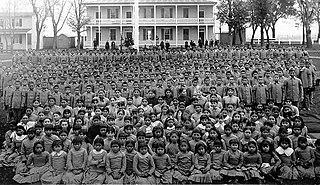
Oklahoma is a landlocked state in the South Central region of the United States. It borders Texas to the south and west, Kansas to the north, Missouri to the northeast, Arkansas to the east, New Mexico to the west, and Colorado to the northwest. Partially in the western extreme of the Upland South, it is the 20th-most extensive and the 28th-most populous of the 50 United States. Its residents are known as Oklahomans and its capital and largest city is Oklahoma City. The state's name is derived from the Choctaw words okla, 'people' and humma, which translates as 'red'. Oklahoma is also known informally by its nickname, "The Sooner State", in reference to the Sooners, settlers who staked their claims in formerly American Indian-owned lands until the Indian Appropriations Act of 1889 authorized the Land Rush of 1889 opening the land to white settlement.

Ottawa County is a county located in the northeastern corner of the U.S. state of Oklahoma. As of the 2020 census, the population was 30,285. Its county seat is Miami. The county was named for the Ottawa Tribe of Oklahoma. It is also the location of the federally recognized Modoc Nation and the Quapaw Nation, which is based in Quapaw.

Miami is a city in and the county seat of Ottawa County, Oklahoma, United States, founded in 1891. Lead and zinc mining were established by 1918, causing the area's economy to boom.

Bixby is a city in Tulsa and Wagoner counties in the U.S. state of Oklahoma, and is a suburb of Tulsa. The population was 28,609 at the 2020 census and 20,884 in the 2010 census, an increase of 13.70 percent In 2010, Bixby became the 19th largest city in Oklahoma. It is nicknamed "The Garden Spot of Oklahoma" for its rich agrarian heritage. Though one of the fastest-growing communities in Oklahoma, it remains a sod-growing center and a popular location for purchasing fresh vegetables. The per capita income of $36,257 is the highest in the Tulsa Metropolitan area and is more than 50 percent higher than the state average.

The Peoria are a Native American people. They are enrolled in the federally recognized Peoria Tribe of Indians of Oklahoma headquartered in Miami, Oklahoma.

Alice Mary Robertson was an American educator, social worker, Native Americans' rights activist, government official, and politician who became the second woman to serve in the United States Congress, and the first from the state of Oklahoma. Robertson was the first woman to defeat an incumbent congressman. She was known for her strong personality, commitment to Native American issues, and anti-feminist stance.

Brigadier General Richard Henry Pratt was an American military officer who founded and was longtime superintendent of the influential Carlisle Indian Industrial School at Carlisle, Pennsylvania.
The Society of American Indians (1911–1923) was the first national American Indian rights organization run by and for American Indians. The Society pioneered twentieth century Pan-Indianism, the movement promoting unity among American Indians regardless of tribal affiliation. The Society was a forum for a new generation of American Indian leaders known as Red Progressives, prominent professionals from the fields of medicine, nursing, law, government, education, anthropology and ministry. They shared the enthusiasm and faith of Progressive Era white reformers in the inevitability of progress through education and governmental action.

William Wayne Keeler was an American engineer, oilman, and tribal chief. He was the last appointed and first elected Principal Chief of the Cherokee Nation in the 20th century. Educated as a chemical engineer, he worked for Phillips Petroleum Company, where he became chief executive officer at the end of a long career with the company. Throughout his life he also worked in the federal government for the advancement of Indians. President Truman appointed him as Principal Chief of the Cherokee Nation of Oklahoma in 1949. He also served as chairman for the executive committee of the Texas Cherokees and Associate Bands from 1939 until 1972. In 1971, he became the Cherokees' first elected chief since 1903.

Appeal to the Great Spirit is a 1908 equestrian statue by Cyrus Dallin, located in front of the Museum of Fine Arts, Boston. It portrays a Native American on horseback facing skyward, his arms spread wide in a spiritual request to the Great Spirit. It was the last of Dallin's four prominent sculptures of Indigenous people known as The Epic of the Indian, which also include A Signal of Peace (1890), The Medicine Man (1899), and Protest of the Sioux (1904).

Bacone College, formerly Bacone Indian University, is a Private college in Muskogee, Oklahoma. Founded in 1880 as the Indian University by missionary Almon C. Bacone, it was originally affiliated with the mission arm of what is now American Baptist Churches USA. Renamed as Bacone College in the early 20th century, it is the oldest continuously operated institution of higher education in Oklahoma. The liberal arts college has had strong historic ties to several tribal nations, including the Muscogee and Cherokee. The Bacone College Historic District has been on the National Register of Historic Places listings in Muskogee County, Oklahoma since 2014.

Albert Andrew "Ex" Exendine was an American football player, coach, and lawyer. He played college football at the Carlisle Indian Industrial School where he was an All-American end. Exendine served as the head football coach at Otterbein College (1909–1911), Georgetown University (1914–1922), the State College of Washington—now known as Washington State University (1923–1925), Occidental College (1926–1927), Northeastern State Teachers' College—now known as Northeastern State University (1928), and Oklahoma Agricultural and Mechanical College—now known as Oklahoma State University (1934–1935). He was also the head baseball coach at Oklahoma A&M from 1932 to 1933, tallying a mark of 19–13. Exendine was inducted into the College Football Hall of Fame as a player in 1970.

The Modoc Nation is a federally recognized tribe of Modoc people, located in Ottawa County in the northeast corner of Oklahoma and Modoc and Siskiyou counties in northeast California. The smallest tribe in the state, they are descendants of Captain Jack's band of Modoc people, removed in 1873 after the Modoc Wars from their traditional territory in northern California and southern Oregon. They were exiled to the Quapaw Agency in Indian Territory, where they were colocated with the Shawnee people from east of the Mississippi River.

Gustavius A. "Gus" Welch was an American football player, track and field athlete, coach of football and lacrosse, and college athletics administrator.

American Indian boarding schools, also known more recently as American Indian residential schools, were established in the United States from the mid-17th to the early 20th centuries with a primary objective of "civilizing" or assimilating Native American children and youth into Anglo-American culture. In the process, these schools denigrated Native American culture and made children give up their languages and religion. At the same time the schools provided a basic Western education. These boarding schools were first established by Christian missionaries of various denominations. The missionaries were often approved by the federal government to start both missions and schools on reservations, especially in the lightly populated areas of the West. In the late 19th and early 20th centuries especially, the government paid religious orders to provide basic education to Native American children on reservations, and later established its own schools on reservations. The Bureau of Indian Affairs (BIA) also founded additional off-reservation boarding schools based on the assimilation model. These sometimes drew children from a variety of tribes. In addition, religious orders established off-reservation schools.

Edna Moscelyne Larkin Jasinski was an American ballerina and one of the "Five Moons", Native American ballerinas from Oklahoma who gained international fame in the 20th century. After dancing with the Original Ballet Russe and the Ballet Russe de Monte Carlo, she and her husband settled in Tulsa, Oklahoma, where in 1956 they founded the Tulsa Ballet and its associated school. It became a major regional company in the American Southwest and made its New York City debut in 1983. She is portrayed in the mural Flight of Spirit displayed in the Rotunda of the Oklahoma State Capitol building.
Hiram Chase, was one of the first Native American Lawyers to argue before the U.S. Supreme Court, and with his partner Thomas L. Sloan, formed the first Native American law firm in the United States. Chase was a leader of the Society of American Indians, the first national American Indian rights organization run by and for American Indians. The Society pioneered twentieth-century Pan-Indianism, the philosophy and movement promoting unity among American Indians regardless of tribal affiliation.

Laura Cornelius Kellogg ("Minnie") ("Wynnogene"), was an Oneida leader, author, orator, activist and visionary. Kellogg, a descendant of distinguished Oneida leaders, was a founder of the Society of American Indians. Kellogg was an advocate for the renaissance and sovereignty of the Six Nations of the Iroquois, and fought for communal tribal lands, tribal autonomy and self-government. Popularly known as "Indian Princess Wynnogene," Kellogg was the voice of the Oneidas and Haudenosaunee people in national and international forums. During the 1920s and 1930s, Kellogg and her husband, Orrin J. Kellogg, pursued land claims in New York on behalf of the Six Nations people. Kellogg's "Lolomi Plan" was a Progressive Era alternative to Bureau of Indian Affairs control emphasizing indigenous American self-sufficiency, cooperative labor and organization, and capitalization of labor. According to historian Laurence Hauptman, "Kellogg helped transform the modern Iroquois, not back into their ancient League, but into major actors, activists and litigants in the modern world of the 20th century Indian politics."
James Hugh McBirney was an Ireland-born Oklahoma banker and bank organizer.

Fayette Avery McKenzie was an American educator and president of Fisk University from 1915 to 1925. He received his doctorate degree from the University of Pennsylvania in 1908. His dissertation, The American Indian in Relation to the White Population of the United States was published. He taught and studied Native Americans and was one of the founders of the Society of American Indians.

















